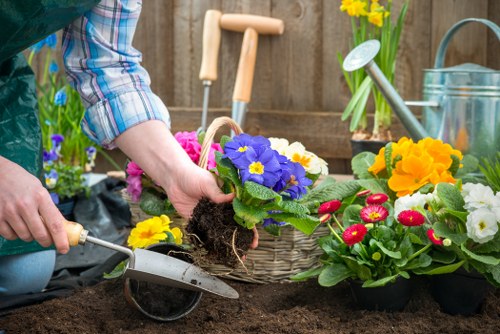Gardeners Grays: Nurturing Nature in Every Shade

Gardening is more than just a hobby; it's a way to connect with nature, cultivate beauty, and enhance our living spaces. In the heart of this green tradition lies the concept of Gardeners Grays, a unique approach that embraces the subtle and elegant tones of gray in gardening. Whether you're an experienced gardener or just starting, understanding the role of grays can transform your garden into a serene and sophisticated sanctuary.
Grays, often overlooked in the vibrant world of gardening, offer a myriad of benefits. They provide a neutral backdrop that highlights the colors of other plants, create a sense of balance, and add depth to garden designs. Additionally, grays are remarkably versatile, blending seamlessly with various styles and themes.
In this article, we will explore the essence of Gardeners Grays, their applications, and how they can enhance your gardening experience. From selecting the right plants to incorporating gray elements in your garden design, we'll cover everything you need to know to make the most of this understated yet impactful approach.

The Beauty of Gardeners Grays
Grays in gardening are not just about color; they embody a sense of calmness and sophistication. Incorporating gray elements can create a tranquil environment, perfect for relaxation and reflection. Here's why Gardeners Grays are gaining popularity:
- Versatility: Gray complements a wide range of colors, making it easy to integrate into any garden palette.
- Elegance: The subtlety of gray adds a touch of elegance without overpowering other design elements.
- Balance: Gray tones help balance the brightness of flowers and the lushness of green foliage.
- Low Maintenance: Many gray plants are hardy and require minimal care, making them ideal for busy gardeners.
Embracing grays doesn't mean sacrificing vibrancy. Instead, it's about creating a harmonious blend where grays enhance and highlight other aspects of your garden.

Choosing the Right Gray Plants
Selecting plants with gray foliage or flowers is the first step in implementing Gardeners Grays. Here are some popular gray plants that can elevate your garden:
- Lavender: Known for its fragrant purple flowers, lavender also features silvery-gray leaves that add texture and color contrast.
- Dusty Miller: With its soft, silvery leaves, Dusty Miller is perfect for creating a striking contrast against colorful blooms.
- Artemisia: This hardy plant has finely divided, silvery-gray foliage that adds depth to garden beds and borders.
- Sage: Beyond its culinary uses, sage plants offer grayish-green leaves and delicate flowers that attract pollinators.
- Heuchera: Also known as coral bells, Heuchera comes in various shades, including beautiful gray tones.
Incorporating a variety of these plants can create a layered and dynamic garden space, showcasing the versatility of gray hues.

Designing with Grays: Tips and Ideas
Integrating grays into your garden design requires thoughtful planning. Here are some tips to help you design a cohesive and visually appealing garden:
- Contrast and Complement: Use gray plants to contrast with bright flowers or to complement other neutral tones in your garden.
- Layering: Create depth by layering plants of different heights and textures, emphasizing the gray elements.
- Accents: Incorporate gray stones, mulch, or garden ornaments to reinforce the gray theme.
- Focal Points: Use standout gray plants as focal points to draw attention and create visual interest.
- Seasonal Variation: Plan for different seasons by selecting gray plants that offer year-round appeal.
By considering these design principles, you can create a balanced and harmonious garden that highlights the beauty of grays.

Maintaining Your Gray Garden
Maintaining a garden with gray elements involves specific care to ensure that the plants retain their color and health. Here are some maintenance tips:
- Proper Watering: Ensure that gray plants receive the right amount of water, as over or under-watering can affect their appearance.
- Pruning: Regular pruning helps maintain the shape and encourages healthy growth in gray plants.
- Soil Health: Enrich the soil with organic matter to support the nutrient needs of your gray plants.
- Pest Control: Monitor for pests and diseases, addressing issues promptly to prevent damage.
- Mulching: Use gray or neutral-colored mulch to retain moisture and suppress weeds.
Consistent maintenance ensures that your gray garden remains vibrant and continues to be a source of beauty and tranquility.
Benefits of Gardeners Grays
Embracing grays in gardening offers numerous benefits beyond aesthetics:
- Stress Reduction: The calming effect of gray tones can reduce stress and promote relaxation.
- Environmental Adaptability: Gray plants are often drought-tolerant and resilient, making them suitable for various climates.
- Year-Round Appeal: Many gray plants offer interest throughout the seasons, ensuring a beautiful garden all year round.
- Enhanced Biodiversity: Gray plants can attract beneficial insects and wildlife, contributing to a healthy ecosystem.
- Sustainability: Low-maintenance gray plants require fewer resources, promoting sustainable gardening practices.
These advantages make Gardeners Grays an excellent choice for those looking to create a beautiful, sustainable, and peaceful garden.
Incorporating Gray Elements Beyond Plants
While gray plants are central to Gardeners Grays, incorporating gray elements beyond foliage can enhance your garden's overall aesthetic:
- Gray Stones and Pebbles: Use gray stones in pathways, borders, or as decorative accents.
- Gray Mulch: Opt for gray-colored mulch to complement gray plants and unify the garden design.
- Garden Furniture: Select gray-toned garden furniture to provide functionality while maintaining the color scheme.
- Ornaments and Decor: Incorporate gray sculptures, birdbaths, or other garden ornaments for added visual interest.
- Structures: Choose gray fencing, trellises, or pergolas to frame your garden and support climbing plants.
These elements work together with your plants to create a cohesive and stylish garden space.
Gray-Themed Garden Ideas
If you're looking for inspiration on how to create a Gardeners Grays theme, here are some ideas to get you started:
- Zen Garden: Utilize gray stones, sand, and minimalist gray plants to create a peaceful and contemplative space.
- Modern Minimalist: Combine sleek gray furniture, geometric plant arrangements, and monochromatic gray plants for a contemporary look.
- Wild Gray Garden: Embrace a more naturalistic approach with gray grasses, wildflowers, and rugged gray elements.
- Gray and Green Harmony: Pair gray plants with lush green foliage to create a balanced and refreshing garden environment.
- Gray Succulent Garden: Focus on various gray-toned succulents for a low-maintenance and visually striking display.
These themes demonstrate the versatility of grays and how they can be adapted to fit different gardening styles and preferences.
Local Relevance: Neighboring Areas to Grays
Gardeners Grays can thrive in various local settings. Here are some of the closest areas to Grays that are ideal for implementing gray-based gardening:
- Stoneham: Known for its rocky soil, Stoneham is perfect for gray plants that thrive in well-drained conditions.
- Riverside Park: The proximity to water bodies makes Riverside Park ideal for combining gray plants with aquatic flora.
- Maplewood: With its temperate climate, Maplewood supports a diverse range of gray foliage plants.
- Sunnyvale: The ample sunlight in Sunnyvale favors sun-loving gray plants like lavender and sage.
- Meadowbrook: Meadowbrook's expansive gardens provide ample space for extensive gray-themed landscapes.
- Oakridge: Oakridge's rich soil is suitable for gray plants that require nutrient-dense environments.
- Brookside: The serene atmosphere in Brookside complements the calming effect of Gardeners Grays.
- Fairview: Fairview's varied terrain allows for creative gray gardening, including hilly or flat garden designs.
- Kingsland: Kingsland offers a community of passionate gardeners who embrace innovative gray gardening techniques.
- Laketown: Laketown's scenic views are enhanced by the subtle beauty of gray plants along pathways and borders.
Each of these areas offers unique features that can be leveraged to create stunning gray gardens, making Gardeners Grays a versatile choice for local gardeners.
Challenges and Solutions
While Gardeners Grays offers many benefits, there are also challenges to consider:
- Perception: Grays are often seen as dull or bland. Overcome this by pairing grays with vibrant colors and diverse textures.
- Plant Selection: Finding the right gray plants that suit your climate and soil can be challenging. Research and consult local nurseries for suitable options.
- Maintenance: Some gray plants may require specific care to maintain their color. Follow appropriate gardening practices to ensure their longevity.
- Integration: Integrating gray elements into existing garden designs can be tricky. Start with small additions and gradually expand as you become more comfortable.
By addressing these challenges with thoughtful planning and proper care, you can successfully implement Gardeners Grays in your garden.
Sustainability with Gardeners Grays
Gardeners Grays contribute to sustainable gardening practices in several ways:
- Water Efficiency: Many gray plants are drought-tolerant, reducing the need for excessive watering.
- Biodiversity: Incorporating a variety of gray plants attracts beneficial insects and promotes a healthy ecosystem.
- Resource Conservation: Gray elements like stones and mulch require minimal maintenance and resources.
- Long-Term Beauty: Gray plants often have a long lifespan, providing lasting beauty without frequent replacements.
- Climate Resilience: Gray plants are typically hardy and adaptable to different climate conditions.
By choosing Gardeners Grays, you're not only enhancing your garden's appearance but also contributing to a more sustainable and eco-friendly environment.
Inspiring Examples of Gray Gardens
Here are a few inspiring examples of Gardeners Grays in action:
- Modern Gray Patio: A sleek gray patio adorned with gray and green plants creates a stylish and inviting outdoor space.
- Gray Rock Garden: Incorporating gray rocks and gravel with silvery succulents and lavender for a low-maintenance, visually appealing garden.
- Gray and White Oasis: Combining gray plants with white flowers and furnishings for a clean and elegant garden design.
- Gray Coastal Garden: Utilizing gray grasses and hardy coastal plants to create a serene seaside-inspired garden.
- Gray Woodland Garden: Integrating gray-toned ferns and mosses into a shaded woodland setting for a natural and peaceful atmosphere.
These examples demonstrate the versatility and beauty of Gardeners Grays, inspiring you to explore and develop your own gray-themed garden.
Conclusion
Gardeners Grays offer a unique and elegant approach to gardening, emphasizing the beauty and versatility of gray tones. By thoughtfully selecting gray plants, incorporating them into your garden design, and maintaining them with care, you can create a serene and sophisticated outdoor space. Whether you're aiming for a modern minimalist look or a naturalistic retreat, Gardeners Grays provide endless possibilities to enhance your garden's appeal.
Embrace the subtlety of grays and discover how this understated color can transform your gardening experience, bringing balance, elegance, and tranquility to your green space.
Frequently Asked Questions
1. What are some easy-to-care-for gray plants for beginners?
Some easy-to-care-for gray plants include Dusty Miller, lavender, sage, and Heuchera. These plants are hardy, require minimal maintenance, and thrive in various conditions.
2. Can gray plants thrive in all climates?
Yes, many gray plants are adaptable to different climates. However, it's essential to choose species that are suited to your local weather conditions and soil type.
3. How do gray plants enhance biodiversity in a garden?
Gray plants attract beneficial insects and pollinators, contributing to a healthy ecosystem. They also provide habitat and food sources for various wildlife species.
4. What are some design ideas for incorporating gray elements in a small garden?
For small gardens, use gray plants in containers, add gray stones or mulch, and include gray garden ornaments. These elements can make the space appear larger and more cohesive.
5. Are there any gray flowering plants?
Yes, lavender and artemisia are examples of gray flowering plants. They offer beautiful flowers while maintaining their characteristic silvery-gray foliage.